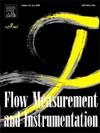Flow measurement of pipeline fluids based on wavenumber-frequency spectrum
IF 2.3
3区 工程技术
Q2 ENGINEERING, MECHANICAL
引用次数: 0
Abstract
Flow is a crucial parameter in industrial production, but traditional flowmeters often face limitations due to the field measurement conditions. This paper explores the array signal processing technology used in passive sonar and details how to measure the flow rate in a pipeline through wavenumber-frequency () spectrum analysis. Firstly, based on the “Taylor frozen” concept of turbulence, the feasibility of using convective velocity to measure the flow rate in a pipeline is studied, and the composition of the disturbance signal is modeled theoretically. Secondly, the signal amplitude and frequency characteristics of water and air are analyzed as the flow rate changes. The Minimum Variance Distortionless Response (MVDR) beamforming algorithm is utilized to address the “convective ridge,” and the slant stack () algorithm helps identify the accurate velocity corresponding to the slope of ridge. Finally, Field experiments were performed using DN50 and DN80 pipelines equipped with piezoelectric sensors. The results showed that the relative errors of water flow and air flow were both less than ±1.0 %, which proved the effectiveness of wavenumber-frequency spectrum method for measuring flow. Therefore, it is of great engineering guiding significance to utilize passive sonar technique to measure pipeline flow.

基于波数-频谱的管道流体流量测量
流量是工业生产中的一个重要参数,但传统的流量计往往受到现场测量条件的限制。本文探讨了被动声呐阵列信号处理技术,并详细介绍了如何通过波数-频率(k−ω)频谱分析来测量管道流量。首先,基于湍流的“泰勒冻结”概念,研究了用对流速度测量管道流量的可行性,并对扰动信号的组成进行了理论建模。其次,分析了水和空气在流量变化时的信号幅值和频率特性。最小方差无失真响应(MVDR)波束形成算法用于解决“对流脊”,倾斜堆栈(τ−v)算法有助于识别与脊斜率对应的准确速度。最后,采用安装了压电传感器的DN50和DN80管道进行了现场实验。结果表明,水流量和空气流量的相对误差均小于±1.0%,证明了波数-频谱法测量流量的有效性。因此,利用被动声呐技术对管道流量进行测量具有重要的工程指导意义。
本文章由计算机程序翻译,如有差异,请以英文原文为准。
求助全文
约1分钟内获得全文
求助全文
来源期刊

Flow Measurement and Instrumentation
工程技术-工程:机械
CiteScore
4.30
自引率
13.60%
发文量
123
审稿时长
6 months
期刊介绍:
Flow Measurement and Instrumentation is dedicated to disseminating the latest research results on all aspects of flow measurement, in both closed conduits and open channels. The design of flow measurement systems involves a wide variety of multidisciplinary activities including modelling the flow sensor, the fluid flow and the sensor/fluid interactions through the use of computation techniques; the development of advanced transducer systems and their associated signal processing and the laboratory and field assessment of the overall system under ideal and disturbed conditions.
FMI is the essential forum for critical information exchange, and contributions are particularly encouraged in the following areas of interest:
Modelling: the application of mathematical and computational modelling to the interaction of fluid dynamics with flowmeters, including flowmeter behaviour, improved flowmeter design and installation problems. Application of CAD/CAE techniques to flowmeter modelling are eligible.
Design and development: the detailed design of the flowmeter head and/or signal processing aspects of novel flowmeters. Emphasis is given to papers identifying new sensor configurations, multisensor flow measurement systems, non-intrusive flow metering techniques and the application of microelectronic techniques in smart or intelligent systems.
Calibration techniques: including descriptions of new or existing calibration facilities and techniques, calibration data from different flowmeter types, and calibration intercomparison data from different laboratories.
Installation effect data: dealing with the effects of non-ideal flow conditions on flowmeters. Papers combining a theoretical understanding of flowmeter behaviour with experimental work are particularly welcome.
 求助内容:
求助内容: 应助结果提醒方式:
应助结果提醒方式:


